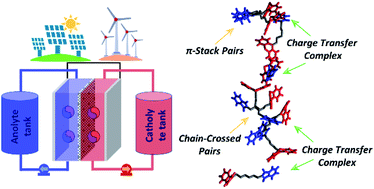Critical role of structural order in bipolar redox-active molecules for organic redox flow batteries†
Abstract
Bipolar redox-active molecules (BRMs) have been suggested as a means to address crossover related issues in all-organic redox flow batteries (RFBs). In such species, electron donors (anolytes) and electron acceptors (catholytes) are linked by a chain, and the same chemical composition is used in both anode and cathode compartments to reduce chemical gradients and unbalanced ion transport. The resultant RFBs resemble the aqueous vanadium RFBs, but offer greater design flexibility and potentially more favorable electrochemical and physicochemical properties. Yet the complex trade-offs in these properties have been a complication. Here we developed a fundamental rubric to uncover the likely origins in the performance metrics of these BRMs that are salient for their use in RFBs. Methylene linked phenothiazine and phthalimide moieties were employed as model BRMs and variations in their properties and molecular conformations were evaluated by systematically varying the methylene linker. Our results revealed that even minimalistic changes in the linker length resulted in dramatic oscillations in the solubility and stability. Using crystallography, quantum chemistry, and molecular dynamics, we clarify that the seemingly fluctuating behavior is due to (1) the inter- and intra-molecular charge transfer between the donor and acceptor through bond or/and through space; (2) the formation of distinctive packing/clustering motifs. Both interactions are strongly dependent on the molecular conformation. As these structural factors modify the electronic structure of both electroactive functional groups and do not change monotonically, the structure–property response in BRMs is often complex. Accordingly, these behaviors need to be taken into account in developing BRMs and knowledge of these structural factors will allow the more rational design of BRMs for grid-scale energy storage.



 Please wait while we load your content...
Please wait while we load your content...
